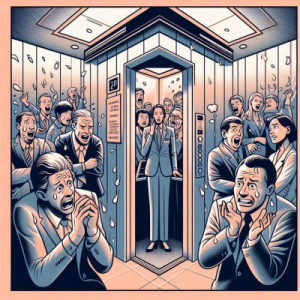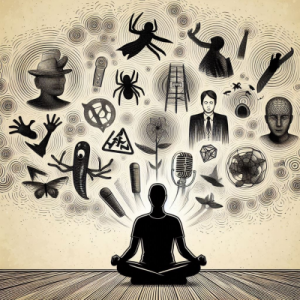Isn’t it a coincidence that you’ve probably heard someone say, “Just get over it!” when it comes to phobias? It’s almost as if there’s a universal manual on how to trivialize deep-seated fears. But let’s cut through the nonsense—phobias aren’t just exaggerated fears, nor do they magically vanish like your willpower at a dessert buffet. So, what’s the real story behind these misconceptions? Spoiler alert: it’s not what you think.
Phobias Are Just Fears
Phobias aren’t just fears; they’re fears on steroids, amped up with a side of irrationality. You think you’re scared of spiders? Well, congratulations! You’ve released the basic level. Phobias take that fear response, crank it up to eleven, and throw in a psychological impact that makes you question your sanity. Suddenly, those harmless eight-legged creatures aren’t just creepy; they’re the stuff of nightmares, lurking in every corner of your mind.
just fears; they’re fears on steroids, amped up with a side of irrationality. You think you’re scared of spiders? Well, congratulations! You’ve released the basic level. Phobias take that fear response, crank it up to eleven, and throw in a psychological impact that makes you question your sanity. Suddenly, those harmless eight-legged creatures aren’t just creepy; they’re the stuff of nightmares, lurking in every corner of your mind.
You might think you can just brush off a phobia as a quirky personality trait. Nope. It’s a full-blown crisis waiting to happen. While a typical fear might leave you a bit jittery, a phobia has you sprinting in the opposite direction, heart racing, palms sweating, and dignity left in the dust. You’ll avoid elevators like they’re the plague just because you can’t stand the thought of being trapped.
But here’s the kicker: your fear response isn’t just overblown; it’s also completely irrational. You know that, right? Logic goes out the window when you’re staring down the barrel of your own anxiety. So, don’t fool yourself into thinking phobias are just fears in disguise. They’re a whole different beast, a psychological rollercoaster that throws you into loops of panic and dread.
In the grand scheme of life, you’d think a little fear wouldn’t be such a big deal. But phobias? They’re your mind’s way of throwing a tantrum, and trust me, it doesn’t play fair.
They Can Be Willed Away
Many people believe they can just will away their phobias, as if sheer determination is the magic wand that banishes anxiety.
You’ve probably heard the mantra: “It’s all in your head!” Sure, because mind over matter is all it takes to conquer a full-blown panic attack when faced with a spider or a crowded elevator. Just think hard enough, and voila! Goodbye, phobia.
Let’s get real. Emotional resilience isn’t built on wishful thinking. It’s forged through facing fears, guided by strategies and tools, not just a mental pep talk.
You can’t just close your eyes and hope the fear evaporates like morning dew. If it were that easy, therapists would be out of business, and self-help books would be bestsellers based on one simple tip: “Just decide to be fearless!”
It’s almost charming how people cling to the idea that phobias are weak moments, easily brushed aside with a firm mindset.
But here’s the kicker: real emotional resilience involves grappling with discomfort, not just pretending it doesn’t exist. You can’t will away a phobia any more than you can will away an elephant in the room.
Only Weak People Have Phobias
Believing that only weak people have phobias is like saying only the fearful get caught in thunderstorms. This myth is a classic example of phobia misconceptions, painting a picture of weakness where emotional resilience should be celebrated.
You might think, “I’m strong; I don’t have phobias.” But guess what? Strength isn’t about being immune to fear; it’s about how you deal with it.
Phobias can grip anyone, from the most robust to the seemingly fragile. Just because someone has a fear doesn’t diminish their character or strength.
Consider this:
- Phobias can stem from past trauma, not weakness.
- Everyone experiences fear, but reactions vary.
- High achievers often battle intense phobias.
- Emotional resilience can coexist with irrational fears.
- Understanding phobias requires empathy, not judgment.
So, if you see someone avoiding heights or spiders, don’t assume they’re weak. They might be traversing a complex emotional landscape you can’t even see.
Instead of scoffing, try to appreciate the strength it takes to face life’s storms. Those who confront their phobias often emerge with newfound emotional resilience, proving that fear isn’t a marker of weakness but a universal human experience.
Next time you encounter a phobia, remember this: It’s not about weakness; it’s about how we all manage our vulnerabilities.
Phobias Are the Same as Anxiety
Fear isn’t a one-size-fits-all jacket; it comes in various cuts and styles.
Let’s get one thing straight: phobias and anxiety aren’t twins separated at birth. Sure, they might share a family tree, but they’re more like distant cousins who only meet at awkward family reunions. You might experience anxiety in the grocery store, sweating over which cereal to buy, while someone else might see a spider and promptly launch into a full-blown panic attack. That’s a phobia for you.
Phobia triggers can turn a normal Tuesday into a horror show. You’ve got your classic fear of heights, the “I-can’t-even-look-out-the-window” panic.
On the other hand, anxiety can lurk like an uninvited guest, gnawing at your insides without a clear cause. There’s an overlap, sure, but let’s not pretend they’re interchangeable, like swapping a latte for a cappuccino.
Phobias are specific, laser-focused fears that can send you spiraling into the depths of despair over something as harmless as a rubber chicken.
Anxiety, meanwhile, is the insidious cloud that hangs over your head, whispering sweet nothings of doubt and dread without a clear target.
Everyone Has Phobias
Phobias are like that unexpected guest at a party—you know they’re there, but you’re not quite sure how they got in. You might think everyone’s got a phobia, and you’d be right. The truth is, phobia prevalence is higher than you’d like to admit.
But don’t worry, you’re not alone in this phobia-fueled carnival of the absurd.
Here’s a fun fact: phobia types range from the mundane to the downright bizarre. You might’ve a fear of spiders, heights, or even the number 13.
Or maybe it’s something more eccentric, like a paralyzing dread of pickles. Yes, those exist!
Consider these delightful phobia tidbits:
- Arachnophobia: Fear of spiders. Because who wouldn’t be terrified of eight-legged intruders?
- Acrophobia: Fear of heights. Perfect for avoiding that tempting mountain hike.
- Cacophobia: Fear of ugliness. A real confidence booster, right?
- Nomophobia: Fear of being without your mobile phone. The modern dilemma!
- Chiraptophobia: Fear of being touched. A great way to avoid awkward hugs.
Exposure Therapy Always Works
So, you’ve decided to immerse yourself in the world of exposure therapy, thinking it’s a magic wand for your phobias. You might believe that by simply facing your fears using a few exposure therapy techniques, you’ll be skipping through life without a care.
But hold on! Reality check: this isn’t a guaranteed cure-all.
Sure, therapists love to tout the therapy effectiveness of exposure therapy, but it’s not some one-size-fits-all solution. Ever tried jumping into a pool when you can’t swim? Yeah, that’s how some people feel when they immerse themselves in these sessions—overwhelmed and flailing. You might find yourself face-to-face with your greatest fear, and it could send you spiraling back to square one, screaming for your blankie.
Let’s not forget that exposure therapy can sometimes trigger even more anxiety. Who knew? You thought confronting your fear would make it all better, but instead, you wish you’d stayed in your safe little bubble. So much for that magic wand, right?
And if you think that just because your buddy got over their arachnophobia, you’ll breeze through your fear of clowns, think again. Everyone’s different, and those techniques may not pack the punch you hoped for.
In the end, exposure therapy can be effective, but it’s not a guaranteed success. Approach it with caution, and maybe keep that magic wand tucked away for now.
Phobias Are Rare
You might think phobias are as rare as a unicorn sighting, but let’s get real—millions of people are grappling with irrational fears every day.
The prevalence rates? They’re higher than you’d like to believe. Phobias affect about 10% of the population at any given time. That’s not “once in a blue moon” rare; that’s a crowded party where everyone’s hiding in the bathroom.
Cultural influences play a massive role in shaping these irrational fears. You mightn’t bat an eye at spiders, but in some cultures, they’re considered harbingers of doom.
Your neighbor could be terrified of clowns, while you’re sweating bullets at the thought of a friendly family barbecue.
Here’s a look at some common phobias that aren’t so rare:
- Arachnophobia (fear of spiders)
- Claustrophobia (fear of confined spaces)
- Agoraphobia (fear of open or crowded spaces)
- Acrophobia (fear of heights)
- Cynophobia (fear of dogs)
Phobias Are Not Serious
Many might scoff at the idea of phobias being serious, brushing them off like a pesky fly. After all, who cares if you can’t walk past a spider or can’t handle elevators? It’s just a little fear, right? Wrong. The emotional impact of phobias can be downright debilitating.
You might think you’re just avoiding that one thing, but that avoidance grows into a fortress, trapping you in a world of anxiety. Imagine living in a constant state of hyper-vigilance, where every shadow feels like a threat. That’s the reality for many dealing with phobia severity.
It’s not just a quirk; it’s a life-altering condition. You might think it’s all in your head, but that’s where the real battle rages. Your mind’s playground becomes a battlefield, and you’re left dodging psychological grenades.
Let’s not glamorize the idea that phobias are trivial. When you see someone freeze at the sight of a dog or break into a sweat at the thought of flying, it’s not just a quirky reaction—it’s a serious emotional struggle.
You think they’re just being dramatic? They’re wrestling with a legitimate fear that can ripple through their entire life.
Children Will Outgrow Phobias
It’s a common belief that kids will just grow out of their fears, like a pesky phase or an outgrown pair of shoes. But let’s face it: childhood development isn’t just a whimsical journey through a field of daisies. Some fears morph into full-blown phobias, clinging to your child like a shadow. Phobia persistence is no joke; it can stick around longer than that unwanted Christmas fruitcake.
You might think:
- Fear of spiders will vanish with age.
- The dark will become less scary as they mature.
- Heights won’t bother them forever.
- Social anxieties will just fade with time.
- Their fear of clowns is merely a phase, right?
Surprise! Phobias can fester, evolve, and become debilitating. Ignoring them, hoping they’ll evaporate with time, is like waiting for a snowstorm in July—delusional at best. You might end up with a teenager who’s still hiding under the covers or avoiding birthday parties because of irrational fears.
Childhood fears can be indicators of deeper issues. Instead of dismissing them, address them head-on. If left unchecked, these fears can morph into lifelong barriers.
Medication Is the Only Solution
With a prescription pad in hand, some might think the only way to tackle phobias is to pop a pill.
Sure, medication can help—if you prefer a quick fix over real solutions. But let’s be real: wouldn’t you rather address the actual problem instead of just numbing it?
Alternative treatments exist, you know. Therapy approaches, like cognitive-behavioral therapy, dive deep into your psyche, helping you understand triggers and develop coping mechanisms.
Imagine actually confronting your fear rather than hiding behind a bottle of pills.
Self-help strategies? They’re not just for the overly optimistic. Simple lifestyle changes, like mindfulness practices or regular exercise, can do wonders for your anxiety levels.
Who knew a brisk walk could be more beneficial than chasing your next dose?
And let’s not forget support systems. Friends, family, or support groups can be your lifebuoys when the waves of phobia crash down.
Professional guidance from a therapist can steer you through the murky waters of your fears, offering insights medication simply can’t.
Conclusion
So, if you think phobias are just silly fears you can laugh off, you’re in for a shocking surprise! They’re not just quirks; they can hijack lives like a villain in a B-movie. And hey, while you’re at it, remember that telling someone to “just get over it” is about as helpful as handing a lifebuoy to a drowning person—completely absurd! Let’s stop the myths and start supporting those who bravely face their demons, one panic attack at a time.





